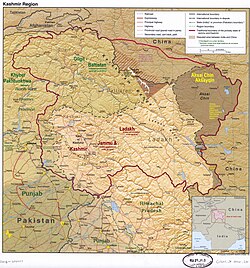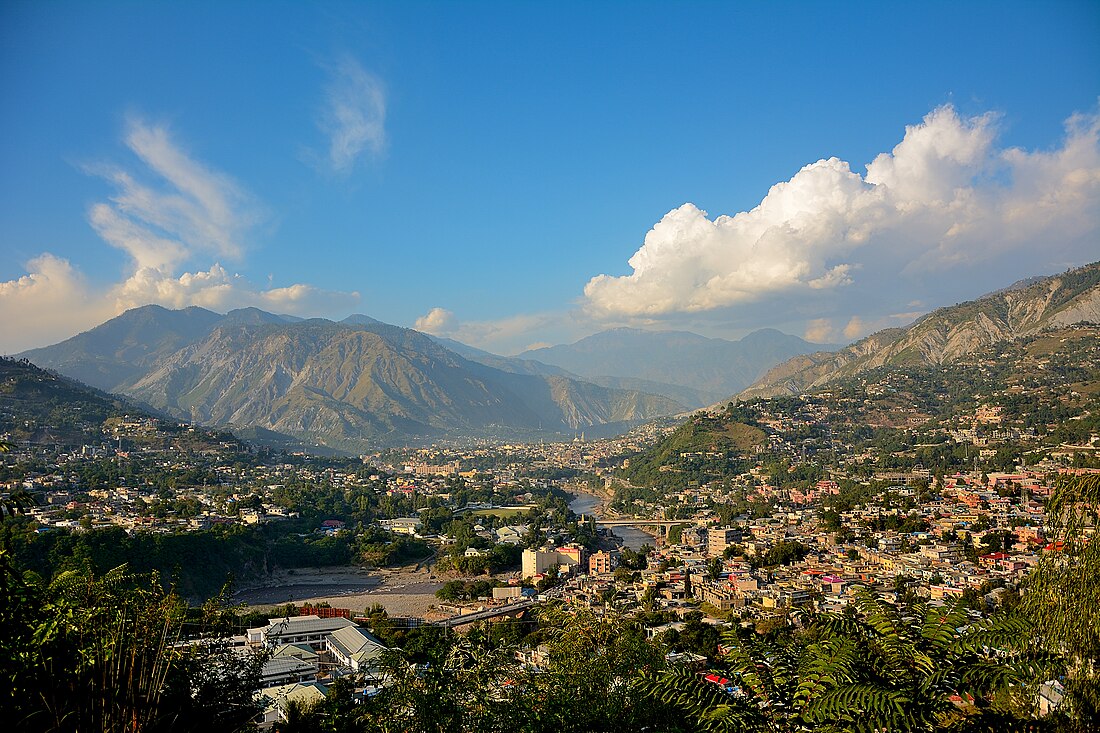Muzaffarabad
Capital of Azad Kashmir, a region administered by Pakistan From Wikipedia, the free encyclopedia
Muzaffarabad (/ˌmʊzəˌfærəˈbæd/;[5] Urdu: مُظَفَّر آباد, IPA: [mʊzəffərɑːbɑːd]) is a city in Pakistani-administered Azad Kashmir in the disputed Kashmir region.[1] It is the largest city and the capital of Azad Kashmir, which is a Pakistani-administered administrative territory.
Muzaffarabad
مظفر آباد | |
|---|---|
City administered by Pakistan | |
 | |
 Interactive map of Muzaffarabad | |
 | |
| Coordinates: 34°21′30″N 73°28′20″E | |
| Administering country | Pakistan |
| Territory | Azad Kashmir |
| District | Muzaffarabad |
| Founded by | Sultan Muzaffar Khan |
| Government | |
| • Mayor | Sikandar Gilani (PML(N)) |
| • Deputy Mayor | Khalid Awan (PPP) |
| • Deputy Commissioner | Tahir Mumtaz BPS-18(PAS) |
| • District Police Officer | Mirza Zahid Hussain BPS-18(PSP) |
| Elevation | 737 m (2,418 ft) |
| Population | |
• City | 149,913 |
| • Rank | 60th, Pakistan |
| Languages | |
| • Official | Urdu[3][4][note 1] |
| • Spoken | |
| Time zone | UTC+05:00 (PST) |
| Calling code | 05822 |
| Website | Muzaffarabad Government Portal (defunct) |
The city is located in Muzaffarabad District, near the confluence of the Jhelum and Neelum rivers. The district is bounded by the Pakistani province of Khyber Pakhtunkhwa in the west, the Kupwara and Baramulla districts of Indian-administered Jammu and Kashmir in the east, and the Neelum District in the north.
History
Summarize
Perspective
Muzaffarabad was founded in 1646 by Sultan Muzaffar Khan, chief of the Bomba tribe[6] who ruled Kashmir.[7] Khan also constructed the Red Fort that same year for the purpose of warding off incursions from the Mughal Empire.
Sikh Empire
In 1827, Raja Zabardast Khan, who had succeeded his father Hassan Ali Khan as the Raja of Muzaffarabad, led a guerrilla campaign against the Sikh Empire, targeting their garrisons in Handwara, Baramulla, and the Hazara region. His leadership and strategic strikes disrupted Sikh control in the area.[8][9]
Gathering a sizable force, Zabardast Khan declared independence and planned an invasion of the Kashmir Valley. In response, Diwan Kirpa Ram led a large Khalsa army to suppress the rebellion. Between Baramula and Muzaffarabad, spanning nearly 77 miles, Zabardast Khan's forces, alongside the local Muslim population, launched persistent attacks on the advancing Sikh army using guerrilla tactics from caves, rocks, and forests. The Sikh forces suffered heavy casualties, and Diwan Kirpa Ram's army faced serious defeats and significant losses.[10]
Indo-Pakistani war of 1947
The Battle of Muzaffarabad occurred on 22 October 1947 between Pakistani-backed Pashtun tribesmen, pro-Pakistani Kashmiri rebels, and the Jammu and Kashmir State Forces in the town of Muzaffarabad. The battle resulted in a rapid defeat of the Jammu and Kashmir State Forces, leading to the capture of Muzaffarabad by the tribesmen.
2005 earthquake
The city was near the epicenter of the 2005 Kashmir earthquake, which had a magnitude of 7.6 Mw. The earthquake destroyed about 50 percent of the buildings in the city (including most government buildings) and is estimated to have killed up to 80,000 people in the Pakistani-controlled areas. As of 8 October 2005[update], the Pakistani government's official death toll was 87,350, while other estimates have put the death toll at over 100,000.[11]
Administrative subdivisions

The district of Muzaffarabad is administratively divided into 2 tehsils, which are subdivided into 25 union councils.[12]
- Muzaffarabad
- Pattika (Naseerabad)
Climate
| Climate data for Muzaffarabad (1961–2009) | |||||||||||||
|---|---|---|---|---|---|---|---|---|---|---|---|---|---|
| Month | Jan | Feb | Mar | Apr | May | Jun | Jul | Aug | Sep | Oct | Nov | Dec | Year |
| Record high °C (°F) | 27.0 (80.6) |
29.4 (84.9) |
37.0 (98.6) |
40.5 (104.9) |
46.5 (115.7) |
46.2 (115.2) |
45.0 (113.0) |
40.2 (104.4) |
39.0 (102.2) |
38.3 (100.9) |
33.0 (91.4) |
27.0 (80.6) |
46.5 (115.7) |
| Mean daily maximum °C (°F) | 16.0 (60.8) |
18.0 (64.4) |
22.6 (72.7) |
28.3 (82.9) |
33.5 (92.3) |
37.4 (99.3) |
34.9 (94.8) |
34.0 (93.2) |
33.4 (92.1) |
30.1 (86.2) |
24.2 (75.6) |
18.1 (64.6) |
22.3 (72.1) |
| Mean daily minimum °C (°F) | 3.1 (37.6) |
5.4 (41.7) |
9.7 (49.5) |
14.2 (57.6) |
18.4 (65.1) |
21.9 (71.4) |
22.8 (73.0) |
22.6 (72.7) |
19.4 (66.9) |
13.7 (56.7) |
7.8 (46.0) |
4.1 (39.4) |
11.1 (52.0) |
| Record low °C (°F) | −3.0 (26.6) |
−1.1 (30.0) |
1.0 (33.8) |
6.5 (43.7) |
7.0 (44.6) |
12.0 (53.6) |
15.5 (59.9) |
16.0 (60.8) |
12.4 (54.3) |
6.5 (43.7) |
1.0 (33.8) |
−1.4 (29.5) |
−3 (27) |
| Average rainfall mm (inches) | 101.3 (3.99) |
137.4 (5.41) |
157.3 (6.19) |
109.0 (4.29) |
78.5 (3.09) |
113.6 (4.47) |
328.7 (12.94) |
229.9 (9.05) |
112.6 (4.43) |
45.9 (1.81) |
37.2 (1.46) |
69.0 (2.72) |
1,242.8 (48.93) |
| Average relative humidity (%) (at 12:00 PST) | 50.3 | 46.3 | 40.9 | 38.0 | 33.2 | 34.0 | 52.2 | 57.6 | 48.1 | 42.4 | 48.4 | 54.0 | 37.2 |
| Source: Pakistan Meteorological Department[13] | |||||||||||||
Transport
Muzaffarabad's public transportation system primarily relies on buses, rickshaws, and small pickup trucks for intracity travel. Following the devastating 2005 earthquake that severely damaged infrastructure, including roads, the city government, with international aid, rebuilt roads, bridges, and other essential infrastructure. However, public transportation remains underdeveloped. Notably, Muzaffarabad lacks a railway system and a functional airport. The nearest railway station is located in the Rawalpindi District of Pakistani Punjab.[14]
Notable people
- Anam Najam, medical doctor and psychiatrist
- Rashid Naseer, Pakistani cricketer
- Farooq Haider Khan, Politician
Gallery
- Heightened view of the city on both riverbanks after the 2005 Kashmir earthquake, c. 2014
- Photo of Muzaffarabad Cricket Stadium
- Photo of the city's skyline, c. 2017
- Azad Jammu Kashmir Medical College
- Muzaffarabad City, Azad Kashmir, Pakistan
See also
Notes
- Snedden (2013, p. 176): On p. 29, the census report states that Urdu is the official language of the government of Azad Kashmir, with Kashmiri, Pahari, Gojri, Punjabi, Kohistani, Pushto, and Sheena 'frequently spoken in Azad Kashmir'. Yet, when surveyed about their 'mother tongue', Azad Kashmiris' choices were limited to selecting from Pakistan's major languages: Urdu, Punjabi, Sindhi, Pushto, Balochi, Saraiki, and 'others'; not surprisingly, 2.18 million of Azad Kashmir's 2.97 million people chose 'others'.
References
Sources
External links
Wikiwand - on
Seamless Wikipedia browsing. On steroids.





